
Mobile is a city and the county seat of Mobile County, Alabama, United States. The population within the city limits was 187,041 at the 2020 census, down from 195,111 at the 2010 census. It is the fourth-most-populous city in Alabama, after Huntsville, Birmingham, and Montgomery.

Spring Hill College is a private, Jesuit college in Mobile, Alabama. It was founded in 1830 by Michael Portier, Bishop of Mobile. Along with being the oldest college or university in the state of Alabama, it was the first Catholic college in the South, is the fifth-oldest Catholic college in the United States, and is the third-oldest member of the Association of Jesuit Colleges and Universities.
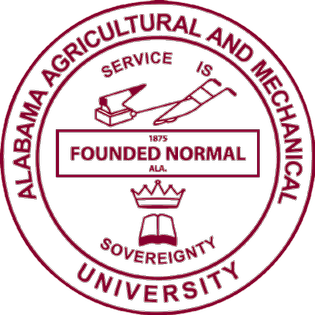
Alabama Agricultural and Mechanical University is a public historically black land-grant university in Normal, Huntsville, Alabama. Founded in 1875, it took its present name in 1969. AAMU is a member-school of the Thurgood Marshall College Fund and is accredited by the Southern Association of Colleges and Schools. Alabama Agricultural and Mechanical University Historic District, also known as Normal Hill College Historic District, has 28 buildings and four structures listed in the United States National Register of Historic Places.

Murphy High School, in Mobile, Alabama, is a public high school operated by the Mobile County Public School System that educates grades 9–12.

The Cochrane–Africatown USA Bridge is a cable-stayed bridge carrying US 90/US 98 Truck across the Mobile River from the mainland to Blakeley Island in Mobile, Alabama.
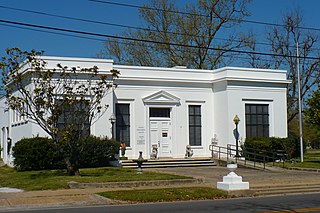
The National African American Archives and Museum, formerly known as the Davis Avenue Branch of Mobile Public Library, is an archive and history museum located in Mobile, Alabama. It serves as a repository for documents, records, photographs, books, African carvings, furniture, and special collections that relate to the African-American experience in the United States. Some of the collection was developed when the building was part of the Mobile Public Library as the Davis Avenue Branch.

The Campground Historic District, also known as The Campground is a historic district in the city of Mobile, Alabama, United States. Named for the Old Camp Ground, a military encampment that occupied the property during the American Civil War, this historically African-American neighborhood was placed on the National Register of Historic Places on July 7, 2005. It is roughly bounded by Martin Luther King Jr. Avenue, Rylands Street, St. Stephens Road, and Ann Street. The district covers 370 acres (1.5 km2) and contains 166 contributing buildings. The houses range from shotgun houses to bungalows and date from the late 19th century to the middle 20th century.

The Thomaston Colored Institute, also known as the Thomaston Academy, is a historic African American school building in the town of Thomaston, Alabama, United States. This two-story brick building was completed in May 1910 as a private school by an African American religious group, the West Alabama Primitive Baptist Association.

Stone Street Baptist Church is a historic African-American Baptist church in Mobile, Alabama. The congregation was established well before the American Civil War, with Stone Street Baptist recognized today as one of Alabama's most influential African-American Baptist churches. It was placed on the National Register of Historic Places on August 8, 1985.

St. Louis Street Missionary Baptist Church is a historic African American church in Mobile, Alabama. It was added to the National Register of Historic Places on October 8, 1976, due to its architectural and historic significance.

Aimwell Baptist Church is a historic African American church in Mobile, Alabama. The Baptist congregation was established in 1890 by two brothers. It took two years for the erection of the first building. The current building, with Gothic Revival influences, was designed in 1946 by Nathaniel Heningburg and incorporates elements from the original structure. It was added to the National Register of Historic Places on May 29, 2008.
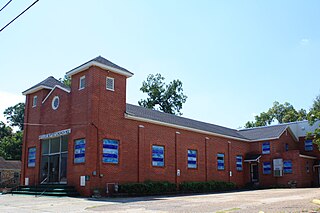
Mt. Olive Missionary Baptist Church No.1 is a historic Missionary Baptist church building in Mobile, Alabama. The church was built in 1916 by the local African American community. It was added to the National Register of Historic Places on May 29, 2008, based on its architectural significance.

The Dave Patton House is a historic house in Mobile, Alabama, United States. The two-story structure was built for Dave Patton, a local African American entrepreneur. He purchased this property in 1900 and completed the Mediterranean Revival style house, designed by local architect George Bigelow Rogers, in 1915.

The Protestant Children's Home, also known as the Protestant Orphans' Asylum, is a historic orphanage building in Mobile, Alabama, United States. It was placed on the National Register of Historic Places on June 18, 1973.
In 2015 the building was leased to the Infant Mystics society which began using it as a meeting lodge, renaming the place Cotton Hall.
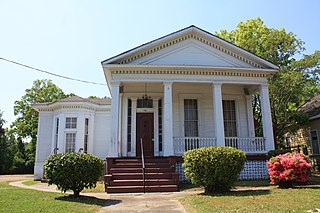
The Weems House, also known as Fowler Cottage, is a historic residence in Mobile, Alabama. Completed in 1870, the one-story frame structure is a late example of the Greek Revival-style. It was added to the National Register of Historic Places on October 7, 1982. The house functioned as a private residence until July 18, 1991, when it was purchased by the Dragons Civic and Social Club, a local fraternal organization.

George Bigelow Rogers (1870–1945) was an American architect, best known for the wide variety of buildings that he designed in Mobile, Alabama, including mansions in historic European styles and other private residences, churches and public buildings, and the first 11-story skyscraper in Mobile and the Southeast United States. Many of his structures have been listed on the National Register of Historic Places.
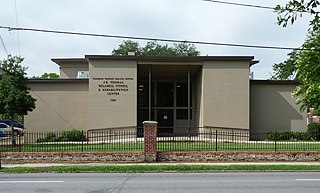
The Davis Avenue Recreation Center is a historic recreation facility in Mobile, Alabama. The facility was established in 1921 as the first public leisure center for African Americans in segregated Mobile. Initially known as the Davis Avenue Community House, it also featured tennis courts, a swimming pool, and a small park. The need for a larger facility was soon realized, and in 1936 the current structure was completed. It was the only public recreation facility in Mobile built using Works Progress Administration funds. It was added to the National Register of Historic Places on June 27, 2011, due to its significance to the African American history in the city.
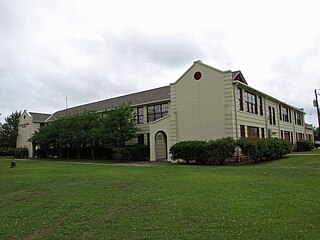
The Caldwell School is a historic former black school building in Mobile, Alabama. The school, originally named the Broad Street Academy, was the first public high school for African Americans in the city. It was founded in 1887, with William A. Caldwell serving as the first principal.






















